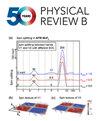Material induced bianisotropy of hybrid nanostructures: From a single meta-atom resonance to metasurfaces with trapped modes
IF 3.7
2区 物理与天体物理
Q1 Physics and Astronomy
引用次数: 0
Abstract
The optical properties of Janus-type hybrid silicon-gold nanocylinders are theoretically studied. We show that the inhomogeneity of the internal material in these particles causes a strong bianisotropic response. Their lack of inversion symmetry formally determines the bianisotropic response of hybrid nanocylinders. We demonstrate a method for obtaining in advance information on nonzero components of the dipole polarizability tensor of hybrid particles by analyzing the relationship between their symmetry properties and the multipole composition of their eigenmodes. The spectral response of metasurfaces composed of a periodic arrangement of such particles can feature strong resonances associated with multipole coupling and the excitation of quasibound states in the continuum (quasi-BICs). Using the resonant bianisotropic properties of the hybrid particles and the ability to tune the quasi-BICs (trapped modes) to a predetermined wavelength by choosing the metasurface period, we demonstrate the excitation of electric and magnetic types of quasi-BICs in the infrared region. The ability to switch between these types of quasi-BICs by changing the incident light polarization is discussed. We also demonstrate that, unlike purely dielectric metasurfaces, the excitation of the quasi-BICs in hybrid metasurfaces leads to a resonant absorption of light.材料诱导的杂化纳米结构的双各向异性:从单元原子共振到具有捕获模式的超表面
对janus型硅金杂化纳米柱的光学性质进行了理论研究。我们发现这些粒子内部材料的不均匀性导致了强烈的双各向异性响应。它们的反演对称性的缺乏正式决定了杂化纳米柱的双各向异性响应。本文通过分析杂化粒子的对称性与其本征模的多极组成之间的关系,给出了一种提前获得杂化粒子偶极极化张量非零分量信息的方法。由这些粒子的周期性排列组成的超表面的光谱响应可以表现出与多极耦合和连续介质中准束缚态激发相关的强共振。利用杂化粒子的共振双各向异性特性和通过选择超表面周期将准bic(捕获模式)调谐到预定波长的能力,我们证明了准bic在红外区域的电和磁激发。讨论了通过改变入射光的偏振来切换这些类型的准bic的能力。我们还证明,与纯介电超表面不同,混合超表面中准bic的激发导致光的共振吸收。2025年由美国物理学会出版
本文章由计算机程序翻译,如有差异,请以英文原文为准。
求助全文
约1分钟内获得全文
求助全文
来源期刊

Physical Review B
物理-物理:凝聚态物理
CiteScore
6.70
自引率
32.40%
发文量
0
审稿时长
3.0 months
期刊介绍:
Physical Review B (PRB) is the world’s largest dedicated physics journal, publishing approximately 100 new, high-quality papers each week. The most highly cited journal in condensed matter physics, PRB provides outstanding depth and breadth of coverage, combined with unrivaled context and background for ongoing research by scientists worldwide.
PRB covers the full range of condensed matter, materials physics, and related subfields, including:
-Structure and phase transitions
-Ferroelectrics and multiferroics
-Disordered systems and alloys
-Magnetism
-Superconductivity
-Electronic structure, photonics, and metamaterials
-Semiconductors and mesoscopic systems
-Surfaces, nanoscience, and two-dimensional materials
-Topological states of matter
 求助内容:
求助内容: 应助结果提醒方式:
应助结果提醒方式:


